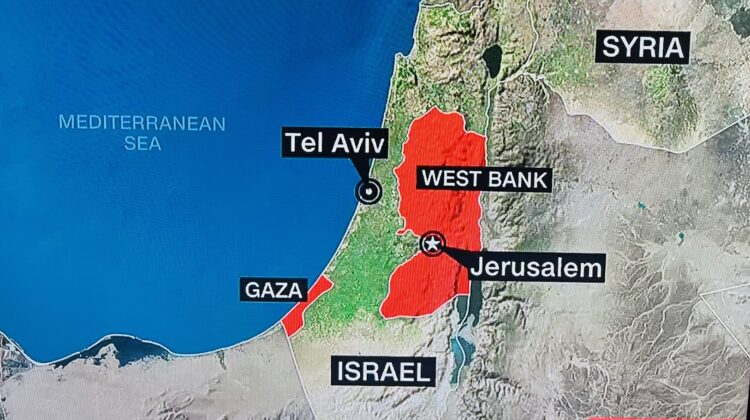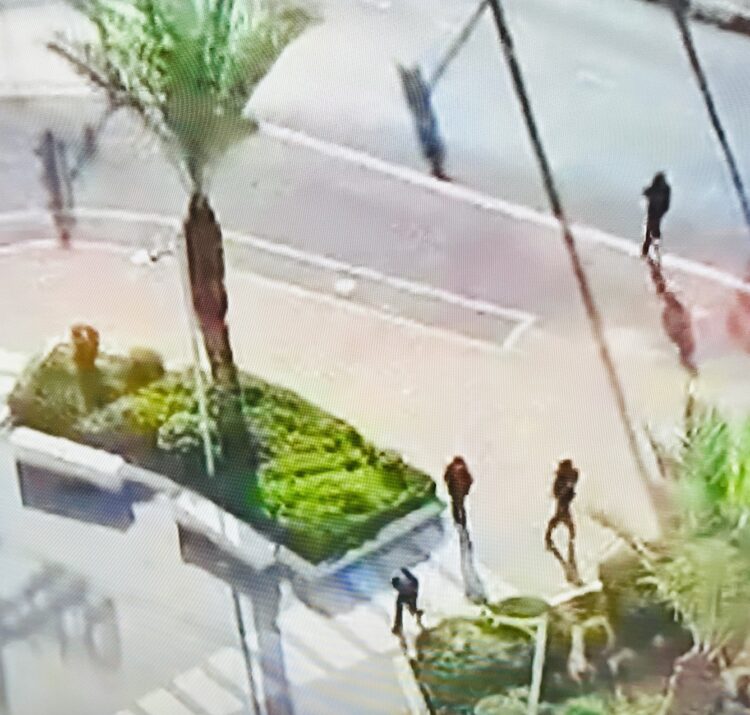It was a stunning, horrific and unprecedented event on a scale that will surely be burned into Israel’s consciousness.
In the early hours of October 7, under the cover of a massive rocket barrage and less than a day after Israel marked the somber 50th anniversary of the outbreak of the Yom Kippur War, hundreds of heavily-armed Hamas fighters from the Gaza Strip penetrated Israel’s border by land, air and sea in the first invasion of its sovereign territory.
It was Israel’s blackest day since statehood 75 years ago.

The infiltration of Palestinian terrorists into Israel is nothing new, of course. During the 1950s, terrorist incidents were quite common. In 1978, a band of Palestinian terrorists hijacked a bus bound for Tel Aviv, resulting in the deaths of 38 Israelis and in Israel’s first invasion of Lebanon in Operation Litani.
In 2002, during the second Palestinian uprising, a Hamas suicide bomber killed 31 Israelis in a hotel in Netanya during Passover, setting off Israel’s temporary reoccupation of Palestinian towns in the West Bank in Operation Defensive Shield. In 2006, Palestinians from Gaza killed two Israeli troops and abducted another soldier, Gilad Shalit, who was held captive for five years and released in exchange for 1,000 Palestinian prisoners.
The latest terrorist attacks are the worst to afflict Israel since the end of the 1948 War of Liberation. Palestinian invaders brazenly attacked at least one army base, several kibbutzim and 22 villages and towns, such as Ofakim and Netivot, within a 24-kilometer radius of Gaza.
It was a bold, coordinated and well-planned cross-border assault that has already claimed the lives of some 600 Israeli civilians and soldiers and injured 2,000.
More than 300 Palestinians have been killed so far.

Pitched battles of the kind that most Israelis could not have imagined erupted in southern Israel as Israeli troops confronted the Palestinian marauders, leaving battered bodies on roads, lanes, sidewalks and apartment flats.
Stark and indelible images emerged on Palestinian social media platforms: A Palestinian bulldozer demolishing the Gaza border fence. Palestinians on motorcycles crashing into Israel territory. An Israeli woman, her face bloodied and her hands tied behind her back, taken prisoner and shoved into a jeep by Palestinian terrorists. Young Palestinian men pulling out the corpse of an Israeli soldier from the turret of a tank.
Muhammad Deif, Hamas’ military commander and the object of several Israeli assassination attempts, urged Palestinians in the West Bank and Israel to “set the earth on fire under the feet of the occupiers” and expel them. He justified the attacks on the basis of Israel’s occupation of the West Bank, Israeli police raids on the Al-Aqsa mosque in eastern Jerusalem, and the imprisonment of thousands of Palestinian militants in Israeli jails.
The Israeli army is still in the process of dislodging the intruders, who have taken 160 hostages and commandeered one tank, one armored personnel carrier and two Magen Adom ambulances.

As these battles raged, Hamas, the governing authority in Gaza, ordered its operatives to launch some 3,000 rockets into Israel. Ashkelon, Tel Aviv, Ashdod, Sderot and Rishon Lezion were among the cities struck. Israeli aircraft carried out retaliatory raids, bombing targets in Gaza and downing a high-rise building in Gaza City.

“We are at war,” Israeli Prime Minister Benjamin Netanyahu said in a televised address. “Not an ‘operation,’ not a ‘round,’ but a war.”

This is Israel’s fifth war against Hamas in 15 years. The first one broke out in 2008, three years after Israel pulled out of Gaza unilaterally during the premiership of Ariel Sharon. Further wars erupted in 2012, 2014 and 2021, forcing Israel to fortify its defences along the border.
This past May, Israel and Islamic Jihad clashed over the course of five days. In the wake of the ceasefire, Islamic leader Ziad Nakhaleh described the truce as “an end of another round of conflict with the Zionist project.”
He was right.
Three weeks before Hamas’ operation, tensions were building ominously, with its leadership encouraging Palestinians to burn tires and detonate explosives along the Israeli border and to launch incendiary balloons into Israel territory. Weekly border protests started in 2018 and ended in 2019, ushering in a brief period of calm and stability.
Gaza, which has been subjected to an Israeli and Egyptian siege since Hamas’ takeover in 2007, has always been a thorn in Israel’s side, particularly since its withdrawal from the congested coastal enclave, which has a population of about two million.
Yet long before Israel dismantled its settlements there and left Gaza, Yitzhak Rabin, the late Israeli prime minister, said, “I wish I could wake up one day and find that Gaza has sunk into the sea.”
Yesterday’s Palestinian assault caught Israel totally by surprise and flat-footed, if only because Hamas had refrained from getting enmeshed in the last two clashes. The consensus in Israel was that Hamas — a pro-Iranian organization that calls for Israel’s destruction and its replacement by an Islamic Arab state — was focused on rebuilding Gaza, which has been devastated by a succession of wars.
Israel, too, was distracted by Palestinian terrorist incidents in the West Bank, which have spiked in the past year and caused the deaths of 34 Israelis and two foreign workers. During this period, more than 200 Palestinians have been killed in clashes with the Israeli army and police.

Israel’s failure to detect Hamas’ attack is regarded as a colossal intelligence and military failure comparable to its state of unpreparedness during the catastrophic opening phase of the Yom Kippur War.
It may well be likened to two defining moments of infamy in American history — Japan’s bombing of the U.S. Pacific fleet in Pearl Harbor on December 7, 1941 and Al Qaeda’s airborne terrorist attack on September 11, 2001 that brought down the World Trade Center in Manhattan.
The ripple effects of both attacks were consequential.
Pearl Harbor prompted U.S. President Franklin D. Roosevelt to declare war on Japan and enter World War II, changing its dynamics ineradicably. Nine/eleven pushed the United States into invading Afghanistan, Al Qaeda’s sanctuary, and occupying Iraq.
With the Palestinian attacks having shocked Israelis to the core, they must now wonder what Israel’s full response will be in the days ahead. Netanyahu has already said that Hamas will “pay an unprecedented price.” He added that the war against Hamas will be lengthy and difficult. “Challenging days are ahead of us. But we will win it.”
Netanyahu warned that Israel will use all its power “to destroy them (Hamas) and to take revenge with force for the day they have inflicted on Israel and on its citizens. We will turn the city of evil into a city of ruins,” he said in a reference to Gaza City. “I say to the residents of Gaza, get out of there now.”

The big question at this point is whether the Israeli army will launch a ground invasion of Gaza, which could be extremely costly in terms of casualties. Israel has mobilized tens of thousands of reservists, but a military solution to what is essentially a political problem seems remote, if not impossible. And with Hamas holding a record number of Israeli hostages, some of whom Israel has managed to rescue, Israel will have to tread carefully before it unleashes a full-scale invasion.
Hezbollah, the pro-Iranian Lebanese militia which has threatened to invade the Galilee should another war in the north break out, fired rockets and mortars at Israeli military sites on Mount Dov on October 8 in support of Hamas. Israel retaliated with artillery fire. In recent months, Hezbollah has staged a series of provocations along the northern border, but Israel has reacted with uncommon restraint.
Yesterday, U.S. President Joe Biden alluded to the possibility of Hezbollah’s intervention in a brief speech during which he fully endorsed Israel’s right of self-defence. As he put it, “Let me say this as clearly as I can. This is not a moment for any party hostile to Israel to exploit these attacks to seek advantage.”
The fighting may delay or even derail Israel’s current efforts to forge formal diplomatic relations with Saudi Arabia. It could also be detrimental to Netanyahu, whose extreme right-wing government must take full responsibility for this fiasco. One of his predecessors, Golda Meir, was compelled to resign due to the widespread belief that Israel was not ready for the Yom Kippur War. Netanyahu, Israel’s longest-serving prime minister, may yet face the same fate.
In all probability, the head of Israeli military intelligence and the director of the Shin Bet internal intelligence agency will be held accountable for this unmitigated disaster.
The war, in the short run, has united Israelis, who for the past nine months have been greatly at odds over Netanyahu’s ill-conceived plan to overhaul the judiciary.
Certainly, Hamas may have been under the grand illusion that the weekly protests over this highly contentious issue would impel some reservists in the armed forces who oppose Netanyahu’s legislation to boycott their respective units. This has not proven to be the case.
Amid a day of profound trauma and immense losses, Israelis have rallied around the flag.
